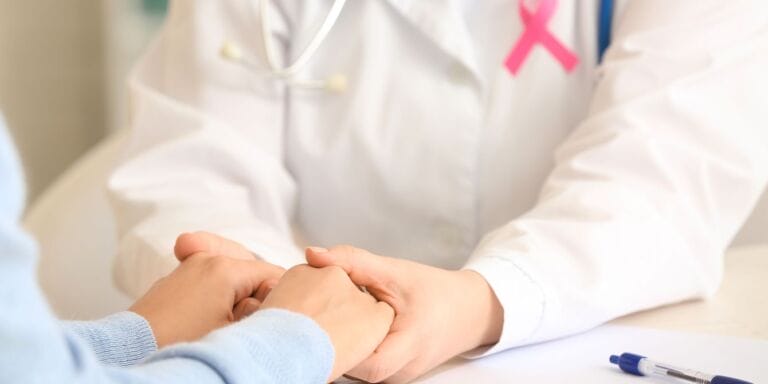Breast health: 9 important facts every woman should know

3. It's possible to reduce your risk of breast cancer.
Table of Contents
Come October, you’ll see pink ribbons and products just about everywhere promoting Breast Cancer Awareness month. Sometimes it seems as though wherever we turn, we hear about someone else being diagnosed with breast cancer.
This disease is unfortunately common—1 in 8 women (approximately 13%) will be diagnosed with breast cancer in their lifetime, and it can be devastating when it happens to someone close to us, but early detection and being aware of your breast health can be instrumental in improving outcomes.
Here are 9 facts about breast cancer every woman should be aware of
1. You can learn about your risk factor from your genes
There are two important genes that can impact your risk for breast cancer: BRCA1 and BRCA2 (commonly called “brack-a.”) Everyone has them and their job is to suppress cancer cells. But 0.25% of women have a mutation in these genes, which means they are not as good at fighting cancer.
Women with these mutations have a higher risk of developing breast cancer by age 70: 55% to 65% chance for BRCA1 and 45% for BRCA2.
So, should you get tested for a BRCA mutation? That is not an easy decision, but your doctor can help you make the call. Things to consider include your family history of breast cancer and what you would do with that new information.
Related: Pregnancy after breast cancer—what an expert wants you to know
2. Babies and age may make a difference, too
If you first got your period younger than age 12, gave birth to your first baby after age 30, or have never given birth, your chances for developing breast cancer are a little higher. You certainly don’t have to be stressed about that risk, just be sure to self-check your breasts monthly and talk to your doctor about prevention and routine screening.
Related: The Home Edit star reveals breast cancer diagnosis
3. It’s possible to reduce your risk of breast cancer
For women with a high risk of breast cancer, research has found that there are some lifestyle changes you can make that may reduce the chances. These include:
- Never smoking or quitting smoking
- Drinking less alcohol (fewer than three drinks per week)
- Exercising regularly
- Maintaining a healthy weight
- Eating nutrient-dense food
Related: How to talk to kids about cancer treatment at any age
4. Birth control may slightly increase your risk
A 2017 study found that women who used hormonal birth control, like the pill or the hormonal IUD, had a slightly higher risk of developing breast cancer—but it’s very slight: One new breast cancer case per every 7,690.
If you are concerned, you can chat with your doctor or midwife about a non-hormonal method of contraception, like condoms, the copper IUD, vasectomies or tubal ligation, and natural family planning.
5. You should check your breasts at least once a month
The best time to do a self-breast exam is a few days after your period ends. If you are pregnant or nursing and don’t have a period, just check on the same day of the month each month. Here’s how to do it:
- Look at your breasts in the mirror, first with your hands on your hips and then with your hand up in the air.
- Feel your breasts while you are standing. This is easiest to do in the shower when they are a bit slippery. How you feel them is up to you, just make sure you cover the whole breast (including the breast tissue that’s in your armpit). Many women like to start at the nipple and move outward in concentric circles until they have covered the whole breast.
- Lay down and feel your breasts. Lay on your back, and place one hand behind your head. Use the other hand to check the breast in the same way as above.
Related: How to perform a self-breast exam
6. Every pair of breasts are different—like these
Keep in mind these are all normal:
- Breasts on the same body can be different sizes
- Breasts may change slightly throughout your life
- You may have hair around your areola
- Breast tissue can be sore or feel different around the time of your period
7. But some self-check findings warrant further investigation
Talk to your doctor if:
- You find or notice a lump or bump or any general hardness
- You see swelling anywhere near your breast, armpit or collarbone
- There are changes to the skin around your nipple
- You notice warmth or itching
- Or notice pus, blood or other liquid leaking from your nipple (other than breast milk)
Related: What not to say when your friend has breast cancer (and what to say instead)
8. There is a mammogram plan, but yours might differ
The American Cancer Society (ACS) recommends the following timeline for mammograms:
- Women between age 40 and 44 can start to have mammograms if they choose to
- Between the ages of 45 and 54, women should have a mammogram every year
- At 55 and older, women can continue yearly mammograms or switch to every other year, as long as she is in good health
Your doctor may also recommend a mammogram if you have an unusual finding or a risk factor. ACS also states “Screening should continue as long as a woman is in good health and is expected to live 10 more years or longer, and all women should be familiar with the known benefits, limitations, and potential harms linked to breast cancer screening.”
Women should also know how their breasts normally look and feel and report any breast changes to a health care provider right away.
9. The survival rate for breast cancer is improving 💪
More than 90% of women with breast cancer will survive. Early detection and treatment really do matter—so never hesitate to reach out to your provider if you have a concern about your breast health.
A version of this story was originally published on Oct. 9, 2018. It has been updated.


































